Bento
Bento (弁当, bentō)[1] is a single-portion take-out or home-packed meal common in Japanese, Taiwanese, and Korean cuisines and other Asian cultures where rice is the main staple food. A traditional bento holds rice or noodles, fish or meat, with pickled and cooked vegetables, in a box.[2] Containers range from mass-produced disposables to hand-crafted lacquerware. Bento are readily available in many places throughout Japan, including convenience stores, bento shops (弁当屋, bentō-ya), railway stations, and department stores. However, Japanese homemakers often spend time and energy on carefully prepared box lunches for their spouses, children, or themselves. Bentos can be elaborately arranged in a style called "kyaraben" ("character bento"). Kyaraben are typically decorated to look like popular characters from Japanese animation (anime), comic books (manga), or video games. Another popular bento style is "oekakiben" or "picture bento". This is decorated to look like people, animals, buildings and monuments or items such as flowers and plants. Contests are often held where bento arrangers compete for the most aesthetically pleasing arrangements.
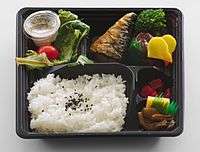
There are somewhat comparable forms of boxed lunches in Asian countries including the Philippines (baon), Korea (dosirak), Taiwan (biàndāng in Mandarin and “piān-tong” in Taiwanese), Thailand (pin-tou), and India (tiffin). Hawaiian culture has also adopted localized versions of bento featuring local tastes after over a century of Japanese influence.
Etymology
In Japan, "bento" is written as 弁当. The word originates from the Southern Song slang term 便当 (便當 (pinyin: biàndāng)), meaning "convenient" or "convenience". When imported to Japan, it was written with the ateji 便道 and 弁道.[3][4]
In Japan, the word "bento" has been used since the 13th century and the container itself, also called "bento", has been known since the 16th century.[3]
In modern times, bento is commonly used in Western countries and East Asia. In mainland China, Hong Kong and Taiwan, "bento" is written as 便當 (pinyin: biàndāng).
History
Kamakura period
The origin of bento can be traced back to the late Kamakura period (1185 to 1333), when cooked and dried rice called hoshi-ii (糒 or 干し飯, literally "dried meal") was developed, to be carried to work.[2] Hoshi-ii can be eaten as is or boiled with water to make cooked rice, and is stored in a small bag. In the Azuchi-Momoyama period (1568–1600), wooden lacquered boxes like today's were produced, and bento would be eaten during a hanami or a tea party.
Edo period
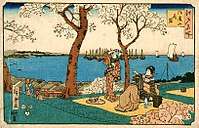
In the Edo period (1603–1867), bento culture spread and became more refined. Travelers and sightseers would carry a simple koshibentō (腰弁当, "waist bento"), consisting of several onigiri wrapped with bamboo leaves or in a woven bamboo box. One of the most popular styles of bento, called makuno-uchi bentō ("between-act bento"), was first made during this period.[5] People who came to see Noh and Kabuki ate specially prepared bentos between maku (acts). Numerous cookbooks were published detailing how to cook, how to pack, and what to prepare for occasions like Hanami and Hinamatsuri.
Meiji Period
In the Meiji period (1868–1912), the first ekibentō or ekiben (駅弁当 or 駅弁, "train station bento") was sold. There are several records that claim where ekiben was first sold, but it is believed that it was sold on 16 July 1885, at the Utsunomiya train station, in the northern Kantō region of Japan, and contained two onigiri and a serving of takuan wrapped in bamboo leaves. As early schools did not provide lunch, students and teachers carried bentos, as did many employees. "European" style bentos with sandwiches also went on sale during this period.
Taishō period
In the Taishō period (1912–1926), the aluminum bento box became a luxury item because of its ease of cleaning and its silver-like appearance. Also, a move to abolish the practice of bento in school became a social issue. Disparities in wealth spread during this period, following an export boom during World War I and subsequent crop failures in the Tohoku region. A bento too often reflected a student's wealth, and many wondered if this had an unfavorable influence on children both physically, from lack of adequate diet, and psychologically, from a clumsily made bento or the richness of food. After World War II, the practice of bringing bentos to school gradually declined and was replaced by uniform food provided for all students and teachers.[6]
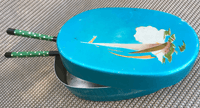
Shōwa and Heisei periods
Bentos regained popularity in the 1980s, with the help of the microwave oven and the proliferation of convenience stores. In addition, the expensive wood and metal boxes have been replaced at most bento shops with inexpensive, disposable polystyrene boxes. However, even handmade bentos have made a comeback, and they are once again a common, although not universal, sight at Japanese schools. Bentos are still used by workers as a packed lunch, by families on day trips, for school picnics and sports days etc. The bento, made at home, is wrapped in a furoshiki cloth, which acts as both bag and table mat.
Airports also offer an analogous version of the ekiben: a bento filled with local cuisine, to be eaten while waiting for an airplane or during the flight.[7]
In other countries
The bento made its way to Taiwan in the first half of the 20th century during the Japanese colonial period and remains very popular to the present day.[8] The Japanese name was borrowed as bendong and now in the 21st century it has reached Pakistan and has become popular among people with the name Bento Box Pakistan.[9] (Taiwanese: piān-tong) or Mandarin biàndāng (便當).[10]
Culture
In Japan, it is common for mothers to make bento for their children to take to school. Because making bento can take a while, some mothers will prepare the ingredients the night before, and then assemble and pack everything the following morning before their children go to school.[11]
It is often a social expectation of mothers to provide bento for their children, to create both a nutritionally balanced and aesthetically pleasing meal.[12] This activity is expected of the mother and emphasized by society at large,[12] and is common in nursery school institutions.
There are many types of bento. The traditional bento, first of all, which is eaten at school or at work; prepared by the mother or the wife. It can also be bought in konbini (mini-markets) or from street vendors who appear on street corners at lunchtime. For those in a hurry who have to spend their lunch time aboard the shinkansen, there is also the bento ekiben which, as its name suggests, is on sale in the stations of the Archipelago. Bento is also present in more solemn moments, even on the Japanese New Year's table for example. Then called osechi, it comes in two or three levels and contains dishes - expensive, even very expensive - that can only be eaten at this high point of the Japanese calendar.[13]
Types
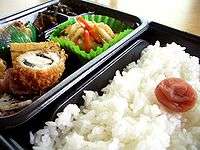
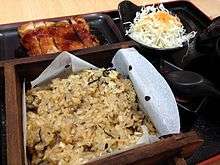
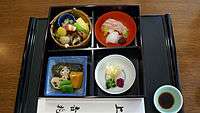
- Chūka bentō (中華弁当) are filled with Chinese food. While Chinese do have cold plates, it is more for appetizers or a midnight "snack".
- Hinomaru bento (日の丸弁当) is the name for a bento consisting of plain white rice with an umeboshi in the centre. The name was taken from the Hinomaru, the Japanese flag, which has a white background with a red circle in the centre. Pure Hinomaru bento only consists of rice and umeboshi to flavor rice without any other side dishes. The metal bento boxes, once popular in Japan, were often corroded by the acid of umeboshi, eventually making a hole in the middle of the lid.
- Kamameshi bentō (釜飯弁当) are sold at train stations in Nagano prefecture. It is cooked and served in a clay pot. The pot is a souvenir item.
- Makunouchi bentō (幕の内弁当) is a classic style of bento with rice, a pickled ume fruit (umeboshi), a slice of broiled salmon, a rolled egg, etc.
- Sake bentō (鮭弁当) is a simple bento with a slice of broiled salmon as the main dish
- Shidashi bentō (仕出し弁当) is made in a restaurant and delivered during lunch. This bento is often eaten at a gathering like a funeral or a party. It is usually packed with traditional Japanese foods like tempura, rice and pickled vegetables. A shidashi bento packed with European-style food is also available.
- Shōkadō bentō (松花堂弁当) is a traditional black-lacquered Japanese bento box. It inspired IBM's (later sold to Lenovo) ThinkPad design.[14]
- Tori bento (鳥弁当) consists of pieces of chicken cooked in sauce served over rice. It is a popular bento in Gunma prefecture.
- Kyaraben (キャラ弁) is a bento made for children with the contents arranged to look like cute characters.
- Shikaeshiben (仕返し弁) is a "revenge" bento where wives make bentos to get back at their husband by writing insults in the food or making the bento inedible.[15]
Other
- Ekiben (駅弁) is a bento sold at railway stations (eki) or onboard trains. There are many kinds of ekiben. Most are inexpensive and filling.
- Hayaben (早弁), literally "early bento", is eating a bento before lunch, and having another lunch afterward.
- Hokaben (ホカ弁) is any kind of bento bought at a take-out bento shops. Freshly cooked hot (hokahoka) rice is usually served with freshly prepared side dishes. The name was popularized after a pioneering take-out bento franchise in the field, Hokka Hokka Tei.
- Noriben (海苔弁) is the simplest bento, with nori dipped in soy sauce covering cooked rice.
- Soraben (空弁) is a bento sold at airports.
Gallery
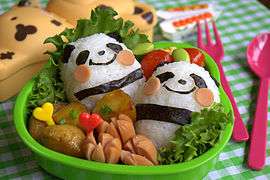 An oekakiben containing rice balls decorated to resemble pandas
An oekakiben containing rice balls decorated to resemble pandas A set of stacking boxes for bento called jūbako
A set of stacking boxes for bento called jūbako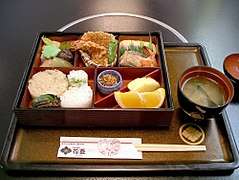 Bento served at a restaurant in Japan
Bento served at a restaurant in Japan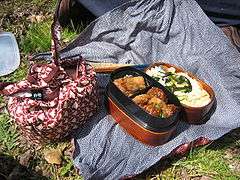 Two typical home made bento (one open, one wrapped); note the furoshiki cloths
Two typical home made bento (one open, one wrapped); note the furoshiki cloths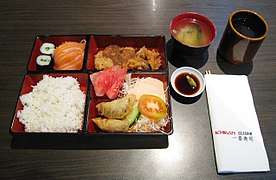
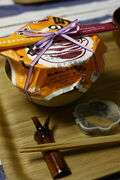
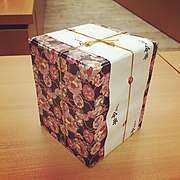 Orizume Bentō (1)
Orizume Bentō (1)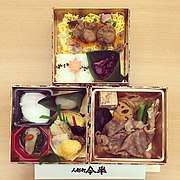 Orizume Bentō (2)
Orizume Bentō (2)
See also
References
- "Bento". Dictionary.com.
- "Bento: Changing New York's Lunch Culture," Chopsticks NY, vol. 27, July 2009, p. 10-11.
- Bento 弁当(べんとう) 語源由来辞典 (Etymology Dictionary)
- Bento (Lunch Box), Japan Hoppers, Retrieved on 29 May 2017
- "Japanese Lunch Boxes - History". web-japan.org. Kids Web Japan. Retrieved 9 December 2013.
- Buck, Stephanie (2016-09-09). "The controversial history of the bento box". Medium. Retrieved 2019-10-01.
- Ashkenazi, Michael; Jacob, Jeanne (2001). The essence of Japanese cuisine: an essay on food and culture. Philadelphia: University of Pennsylvania Press. p. 226. ISBN 9780812235661.
- Chen, Karissa (2019-03-06). "Taiwan's Train Food Puts Amtrak to Shame". Eater. Retrieved 2019-06-05.
- https://bentoboxpak.com
- Hiufu Wong, Maggie. "40 of the best Taiwanese foods and drinks". edition.cnn.com. CNN. Retrieved 8 April 2020.
- Siegel, Bettina. "The Adorable Lunch, Part 2: My Interview With Bento Moms". The Lunch Tray. Retrieved 13 December 2016.
- Allison, Anne (2000). Permitted and Prohibited Desires. Berkeley, California: University of California Press. pp. 81–104.
- "What is the origin of bento?". Bento-cook. Retrieved 2020-04-24.
- Golden, Peter (January 1, 1999). "Big Blue's big adventure". EDN. Archived from the original on June 20, 2012. Retrieved 2007-03-24.
- "Revenge bento show us it's a dish best served cold (and boxed) with insults and hidden chilies". SoraNews24. 2015-02-28. Retrieved 2017-07-11.